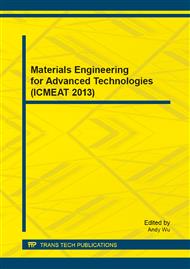[1]
P. Upham, L. Dendler, and M. Bleda. Carbon labelling of grocery products: public perceptions and potential emissions reductions. Journal of Cleaner Production 19. 4 (2011): 348-355.
DOI: 10.1016/j.jclepro.2010.05.014
Google Scholar
[2]
H Dong, Y Geng, F Xi, and T FujitaH. Dong. Carbon footprint evaluation at industrial park level: A hybrid life cycle assessment approach. Journal of Energy Policy 57 (2013): 298-307.
DOI: 10.1016/j.enpol.2013.01.057
Google Scholar
[3]
G. Edwards-Jone, et al. Vulnerability of exporting nations to the development of a carbon label in the United Kingdom. Environmental Science & Policy 12. 4 (2009): 479-490.
DOI: 10.1016/j.envsci.2008.10.005
Google Scholar
[4]
X. Dan. Low-carbon economy-The trend of world economy development. Environmental Science and Information Application Technology (ESIAT) International Conference on. Vol. 3. IEEE (2010).
DOI: 10.1109/esiat.2010.5568368
Google Scholar
[5]
M. Berners-Lee, D.C. Howard, J Moss, and K. Kaivanto. Greenhouse gas footprinting for small businesses-The use of input-output data. Science of the Total Environment 409 (2011): 883-891.
DOI: 10.1016/j.scitotenv.2010.11.023
Google Scholar
[6]
S. Conejos, C. Langston, and J. Smith. Designing for better building adaptability: A comparison of adaptSTAR and ARP models. Habitat International 41 (2014): 85-91.
DOI: 10.1016/j.habitatint.2013.07.002
Google Scholar
[7]
S. T. Ng, J. M. Wong, and M. Skitmore. Challenges facing carbon dioxide labelling of construction materials. Proceedings of the ICE-Engineering Sustainability 166. 1 (2013): 20-31.
DOI: 10.1680/ensu.11.00028
Google Scholar
[8]
K. Plassmann, et al. Methodological complexities of product carbon footprinting: a sensitivity analysis of key variables in a developing country context. Environmental Science & Policy 13 (2010): 393-404.
DOI: 10.1016/j.envsci.2010.03.013
Google Scholar
[9]
R.H. Crawford. Post-occupancy life cycle energy assessment of a residential building in Australia. Architectural Science Review (2013).
DOI: 10.1080/00038628.2013.819556
Google Scholar
[10]
M. Cheung and J. Fan. Carbon reduction in a high-density city: A case study of Langham Place Hotel Mongkok Hong Kong. Renewable Energy 50 (2013): 433-440.
DOI: 10.1016/j.renene.2012.06.060
Google Scholar
[11]
Information on http: /www. pps. go. kr.
Google Scholar
[12]
L.W.P. Ho, N. M. Dickinson, and G. Chan. Green procurement in the Asian public sector and the Hong Kong private sector. Natural Resources Forum 34 (2010): 24-38.
DOI: 10.1111/j.1477-8947.2010.01274.x
Google Scholar
[13]
Information on http: /www. me. go. kr/index. jsp.
Google Scholar
[14]
Y. Park, J. Kim, and K. Kim. Study for the Design of Zero-carbon City through the Application of Renewable Energies. Journal of The Korean Society for New and Renewable Energy v. 6 no. 4 (2010): 15-29.
Google Scholar
[15]
C. C. Cheng, Electricity demand-side management for an energy efficient future in China: Technology options and policy priorities. Doctoral Thesis. Massachusetts, USA: Massachusetts Institute of Technology (2005).
Google Scholar
[16]
D. Browne, O'R. Bernadette, and M. Richard. Use of carbon footprinting to explore alternative household waste policy scenarios in an Irish city-region., Resources, Conservation and Recycling 54. 2 (2009): 113-122.
DOI: 10.1016/j.resconrec.2009.07.003
Google Scholar
[17]
D. Quack. Requirements on consumer information about product carbon footprint. Commissioned by: ANEC, the European consumer voice in standardisation, AISBL, Brussels, Belgium. Final Report (2010).
Google Scholar


